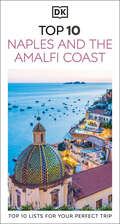- Table View
- List View
DK Top 10 Madrid (Pocket Travel Guide)
by DK TravelA bustling yet intimate city, Madrid exudes culture and creativity in its world-class art galleries, atmospheric tapas bars, glorious gardens and historic plazas. Your DK Eyewitness Top 10 travel guide ensures you’ll find your way around Madrid with absolute ease.Our updated Top 10 travel guide breaks down the best of Madrid into helpful lists of ten – from our own selected highlights to the best museums and galleries, places to eat and shops. Our updated 2022 travel guide brings Madrid to life. DK Eyewitness Top 10 Madrid is your ticket to the trip of a lifetime. Inside DK Eyewitness Top 10 Madrid you will find:- Nine easy-to-follow itineraries , perfect for a day trip, a weekend, or a week- Detailed Top 10 lists of Madrid’s must-sees, including comprehensive descriptions of the Palacio Real, Museo Nacional del Prado, Plaza Mayor, Real Basílica de San Francisco el Grande, El Rastro, Museo Nacional Thyssen-Bornemisza, Museo Nacional Centro de Arte Reina Sofía, Parque del Retiro, Museo Arqueológico Nacional and El Escorial.- Madrid’s most interesting areas, with the best places for shopping, going out and sightseeing- Inspiration for different things to enjoy during your trip – including family activities and things to do for free- A laminated pull-out map of Madrid, plus seven full-color area maps- Practical advice: for getting ready, getting around, and staying safeLooking for more on Madrid’s culture, history and attractions? Try our DK Eyewitness Madrid and DK Eyewitness Spain.About DK Eyewitness: At DK Eyewitness, we believe in the power of discovery. We make it easy for you to explore your dream destinations. DK Eyewitness travel guides have been helping travellers to make the most of their breaks since 1993. Filled with expert advice, striking photography and detailed illustrations, our highly visual DK Eyewitness guides will get you closer to your next adventure. We publish guides to more than 200 destinations, from pocket-sized city guides to comprehensive country guides. Named Top Guidebook Series at the 2020 Wanderlust Reader Travel Awards, we know that wherever you go next, your DK Eyewitness travel guides are the perfect companion.
DK Top 10 Mallorca (Pocket Travel Guide)
by DK TravelMallorca has it all: a spectacular coastline and gorgeous beaches, a proliferation of ancient sites and castles, a stylish capital, and an arresting mountainous interior peppered with picturesque villages, hiking trails and abundant wildlife.Make the most of your trip to this beautiful island with DK Eyewitness Top 10. Planning is a breeze with our simple lists of ten, covering the very best that Mallorca has to offer and ensuring that you don’t miss a thing. Best of all, the pocket-friendly format is light and easily portable; the perfect companion while out and about. Our updated 2022 travel guide brings Mallorca to life. DK Eyewitness Top 10 Mallorca is your ticket to the trip of a lifetime. Inside DK Eyewitness Mallorca you will find: - Up-to-date information with insider tips and advice for staying safe- Top 10 lists of Mallorca's must-sees, including detailed descriptions of La Seu, Castell de Bellver, Fundació Pilar i Joan Miró, La Granja, Valldemossa, Sóller Valley, Monestir de Nostra Senyora de Lluc, Península de Formentor, Alcúdia and Coves del Drac- Mallorca's most interesting areas, with the best places for shopping, going out, andsightseeing- Inspiration for different things to enjoy during your trip – including walks and drives, children's activities and things to do for free- Seven easy-to-follow itineraries, perfect for a day-trip, a weekend, or a week- A laminated pull-out map of Mallorca, plus five color area mapsAbout DK Eyewitness: At DK Eyewitness, we believe in the power of discovery. We make it easy for you to explore your dream destinations. DK Eyewitness travel guides have been helping travellers to make the most of their breaks since 1993. Filled with expert advice, striking photography and detailed illustrations, our highly visual DK Eyewitness guides will get you closer to your next adventure. We publish guides to more than 200 destinations, from pocket-sized city guides to comprehensive country guides. Named Top Guidebook Series at the 2020 Wanderlust Reader Travel Awards, we know that wherever you go next, your DK Eyewitness travel guides are the perfect companion.
DK Top 10 Malta and Gozo (Pocket Travel Guide)
by DK TravelAn unbeatable, pocket-sized guide to Malta and Gozo, packed with insider tips and ideas, color maps, top 10 lists and a laminated pull-out map, all designed to help you see the very best of Malta and Gozo.Step back in time to explore the ancient cities of Mdina and Rabat, marvel at the splendid Gran Master’s Palace in Valletta, explore the historic streets of Birgu (Vittoriosa), the charming bay in Marsaxlokk, or snorkel in the Mediterranean off the beautiful island of Gozo. From top 10 outdoor activities to top 10 walks and drives, discover the best of the Maltese archipelago with this easy-to-use travel guide.DK Eyewitness Top 10 Malta and Gozo is your ticket to the trip of a lifetime. Inside DK Eyewitness Top 10 Malta and Gozo you will find: - Eight easy-to-follow itineraries, perfect for a day trip, a weekend, or a week - Top 10 Lists showcase best attractions in Malta and Gozo, covering St John’s Co-Cathedral, Mnajdra and Ħaġar Qimtemples, Comino, and more- Free laminated pull-out map of Malta and Gozo , plus six full-color area maps- In-depth area guides explore Malta and Gozo’s most interesting neighborhoods , with the best places for shopping,going out and sightseeing- Color-coded chapters divided by area make it easy to find information quickly and plan your day- Essential travel tips including our expert choices of where to stay, eat, shop and sightsee, plus useful transport, visaand health information- Color maps help you navigate with ease- Covers Valletta; Around Sliema, St Julian’s and the Three Cities; Northern Malta; Central Malta; Southern Malta; Gozo and CominoAbout DK Eyewitness: At DK Eyewitness, we believe in the power of discovery. We make it easy for you to explore your dream destinations. DK Eyewitness travel guides have been helping travellers to make the most of their breaks since 1993. Filled with expert advice, striking photography and detailed illustrations, our highly visual DK Eyewitness guides will get you closer to your next adventure. We publish guides to more than 200 destinations, from pocket-sized city guides to comprehensive country guides. Named Top Guidebook Series at the 2020 Wanderlust Reader Travel Awards, we know that wherever you go next, your DK Eyewitness travel guides are the perfect companion.
DK Top 10 Marrakech (Pocket Travel Guide)
by DK TravelBacked by the purple peaks of the Atlas Mountains, the pink ramparts, labyrinthine alleys and magnificent mosques of Marrakech hold a dramatic aura that have attracted visitors for centuries.Make the most of your trip to this magical city with DK Eyewitness Top 10. Planning is a breeze with our simple lists of ten, covering the very best that Marrakech has to offer and ensuring that you don’t miss a thing. Best of all, the pocket-friendly format is light and easily portable; the perfect companion while out and about. DK Eyewitness Top 10 Marrakech is your ticket to the trip of a lifetime. Inside DK Eyewitness Top 10 Marrakech you will find: - Top 10 lists of Marrakech’s must-sees, including Jemaa el Fna, Koutoubia Mosque, the Majorelle Gardens and Badii Palace.- Marrakech’s most interesting areas, with the best places for sightseeing, food and drink, and shopping- Themed lists, including the best restaurants, day trips, nightlife and much more- Easy-to-follow itineraries, perfect for a day trip, a weekend or a week- A laminated pull-out map of Marrakech, plus five full-color area mapsPlanning on touring the country? Don’t forget to check out DK Eyewitness Travel Guide Morocco.About DK Eyewitness: At DK Eyewitness, we believe in the power of discovery. We make it easy for you to explore your dream destinations. DK Eyewitness travel guides have been helping travellers to make the most of their breaks since 1993. DK Eyewitness travel guides have been helping travelers to make the most of their breaks since 1993. Filled with expert advice, striking photography and detailed illustrations, our highly visual DK Eyewitness guides will get you closer to your next adventure. We publish guides to more than 200 destinations, from pocket-sized city guides to comprehensive country guides. Named Top Guidebook Series at the 2020 Wanderlust Reader Travel Awards, we know that wherever you go next, your DK Eyewitness travel guides are the perfect companion.
DK Top 10 Mexico City (Pocket Travel Guide)
by DK TravelDK Eyewitness Travel Guide: Top 10 Mexico City will lead you straight to the very best the city has to offer. Whether you're looking for the things not to miss at the Top 10 sights or want to find the best nightspots, this guide and its pull-out map is the perfect pocket-sized companion.The guide is divided by area with restaurant reviews for each, as well as recommendations for hotels, bars and places to shop. Rely on dozens of Top 10 lists, from the Top 10 museums to the Top 10 events and festivals. There's even a list of the Top 10 things to avoid.You'll find the insider knowledge you need to explore this city with DK Eyewitness Travel Guide: Top 10 Mexico City and its pull-out map.
DK Top 10 Montenegro (Pocket Travel Guide)
by DK TravelMake travel easy with Top 10’s simple lists of tenThe world’s favourite pocket travel guidesMake the most of your trip to Montenegro with this brand new Top 10 guide. Planning is a breeze with our simple lists of ten, covering the very best that Montenegro has to offer and ensuring that you don’t miss a thing. Best of all, the pocket-friendly format is light and easily portable; the perfect companion while out and about.Inside this first edition to Montenegro, you’ll find:- Top 10 lists of Montenegro's must-sees and must-dos, including strolling the walled village of Sveti Stefan, exploring the cliff-side Ostrog Monastery and hiking in the mountains- Montenegro’s most interesting areas, with the best places for sightseeing, food and drink, and shopping- Themed lists, including the best outdoor activities, beaches, walled towns, local dishes and much more- Easy-to-follow itineraries, perfect for a day trip, a weekend or a week- A laminated pull-out map of Montenegro, plus full-colour maps for each areaDK’s Top 10 travel guides have been helping travellers to make the most of their breaks since 2002.
DK Top 10 Montreal and Quebec City (Pocket Travel Guide)
by DK TravelMake the most of your trip to Montreal and Quebec City with DK Eyewitness Top 10. Planning is a breeze with our simple lists of ten, covering the best that Montreal and Quebec City offer and ensuring you don't miss anything. The pocket-friendly format is light and easily portable, the perfect companion while out and about.Inside, you'll find:Top 10 lists of Montreal and Quebec City's must-sees, including the Basilique Notre-Dame, Parc du Mont-Royal, La Citadelle, Île d'Orléans and Les LaurentidesMontreal and Quebec City's most interesting areas, with the best places for sightseeing, food and drink, and shoppingThemed lists, including the best outdoor activities, parks and waterways, historic sites, festivals and events and much moreEasy-to-follow itineraries, perfect for a day trip, a weekend, or a weekA laminated pull-out map of Montreal and Quebec City, plus six full-colour area mapsDK Eyewitness Top 10s have been helping travellers to make the most of their breaks since 2002.Looking for more on Canada's culture, history and attractions? Try our DK Eyewitness Canada.
DK Top 10 Munich (Pocket Travel Guide)
by DK TravelProst! Immerse yourself in Munich’s enchanting Baroque churches, magnificent royal residences, peaceful gardens, world-class museums and boisterous beer halls. Your DK Eyewitness Top 10 travel guide ensures you’ll find your way around Munich with absolute ease.Our newly updated Top 10 travel guide breaks down the best of Munich into helpful lists of ten — from our own selected highlights to the best museums, traditional taverns, places to eat, shops and festivals.You'll discover: • Nine easy-to-follow itineraries, perfect for a day-trip, a weekend, or a week • Detailed Top 10 lists of Munich’s must-sees, including detailed descriptions of Marienplatz, Frauenkirche, Residenz, Pinakotheken, Englischer Garten, Deutsches Museum, Schloss Nymphenburg, Olympiapark, Oktoberfest and Neuschwanstein • Munich’s most interesting areas, with the best places for shopping, dining, and sightseeing • Inspiration for different things to enjoy during your trip – including children’s attractions, things to do for free and must-see experiences off the beaten track • A laminated pull-out map of Munich, plus eight color area maps • Street-smart advice: get ready, get around, and stay safe • A lightweight format perfect for your pocket or bag when you’re on the move DK Eyewitness Top 10s have been helping travelers to make the most of their breaks since 2002. Looking for more on Munich’s culture, history and attractions? Try our DK Eyewitness Munich and the Bavarian Alps and DK Eyewitness Germany.
DK Top 10 Naples and the Amalfi Coast (Pocket Travel Guide)
by DK TravelWith vibrant city streets, sun-kissed beaches, ancient cities and island paradises on offer, it's hard to not fall in love with this region. Your DK Eyewitness Top 10 travel guide ensures you'll find your way around Naples and the Amalfi Coast with absolute ease.Our regularly updated Top 10 travel guide breaks down the best of Naples and the Amalfi Coast into helpful lists of ten - from our own selected highlights to the best piazzas and fountains, beaches, romantic spots, restaurants and shops.You'll discover:• Seven easy-to-follow itineraries, perfect for a day trip, a weekend, or a week• Detailed Top 10 lists of Naples and the Amalfi Coast's must-sees, including comprehensive descriptions of the Palazzo Reale, Castel Nuovo, Duomo, Museo Archeologico Nazionale, Capodimonte, Certosa e Museo di San Martino, Pompeii, Herculaneum, Capri, Amalfi, Ravello, Positano and Paestum• Naples and the Amalfi Coast's most interesting areas, with the best places for shopping, savoring Neapolitan cuisine and sightseeing • Inspiration for different things to enjoy during your trip - including family activities, hidden gems off the beaten track and things to do for free • A laminated pull-out map of Naples and the Amalfi Coast, plus five full-color neighborhood maps• Street-smart advice: get ready, get around, and stay safe• A lightweight format perfect for your pocket or bag when you're on the moveDK Eyewitness Top 10s have been helping travelers to make the most of their breaks since 2002.Looking for more on Italy's culture, history and attractions? Try our DK Eyewitness Naples and the Amalfi Coast or our DK Eyewitness Italy.
DK Top 10 New York City
by DK TravelMallorca has it all: a spectacular coastline and gorgeous beaches, a proliferation of ancient sites and castles, a stylish capital, and an arresting mountainous interior peppered with picturesque villages, hiking trails and abundant wildlife.Make the most of your trip to this beautiful island with DK Eyewitness Top 10. Planning is a breeze with our simple lists of ten, covering the very best that Mallorca has to offer and ensuring that you don’t miss a thing. Best of all, the pocket-friendly format is light and easily portable; the perfect companion while out and about. Our updated 2022 travel guide brings Mallorca to life. DK Eyewitness Top 10 Mallorca is your ticket to the trip of a lifetime. Inside DK Eyewitness Mallorca you will find: - Up-to-date information with insider tips and advice for staying safe- Top 10 lists of Mallorca's must-sees, including detailed descriptions of La Seu, Castell de Bellver, Fundació Pilar i Joan Miró, La Granja, Valldemossa, Sóller Valley, Monestir de Nostra Senyora de Lluc, Península de Formentor, Alcúdia and Coves del Drac- Mallorca's most interesting areas, with the best places for shopping, going out, andsightseeing- Inspiration for different things to enjoy during your trip – including walks and drives, children's activities and things to do for free- Seven easy-to-follow itineraries, perfect for a day-trip, a weekend, or a week- A laminated pull-out map of Mallorca, plus five color area mapsAbout DK Eyewitness: At DK Eyewitness, we believe in the power of discovery. We make it easy for you to explore your dream destinations. DK Eyewitness travel guides have been helping travellers to make the most of their breaks since 1993. Filled with expert advice, striking photography and detailed illustrations, our highly visual DK Eyewitness guides will get you closer to your next adventure. We publish guides to more than 200 destinations, from pocket-sized city guides to comprehensive country guides. Named Top Guidebook Series at the 2020 Wanderlust Reader Travel Awards, we know that wherever you go next, your DK Eyewitness travel guides are the perfect companion.
DK Top 10 New York City (Pocket Travel Guide)
by DK TravelExhilarating, ever-evolving and unforgettable-New York is one of the most visited cities in the world, known for its world-class museums and galleries, dazzling Broadway shows, towering skyscrapers, amazing food, and fast-paced life. Your DK Eyewitness Top 10 travel guide ensures you'll find your way around New York City with absolute ease.Our annually updated Top 10 travel guide breaks down the best of New York City into helpful lists of ten-from our own selected highlights to the best museums, art galleries, restaurants, performing arts venues, children's attractions, LGBTQ+ points of interest, and famous department stores.You'll discover:- Fifteen easy-to-follow itineraries, perfect for a day trip, a weekend, or a week- Top 10 lists of New York City's must-sees, including detailed descriptions of the Empire State Building, American Museum of Natural History, Solomon R. Guggenheim Museum, Rockefeller Center, Fifth Avenue, the Statue of Liberty, Ellis Island, Times Square and Theater District, Central Park and the Metropolitan Museum of Art- New York City's most interesting areas, with the best places for shopping, going out, and sightseeing- Inspiration for different things to enjoy during your trip - including festival and events, bars and lounges, hidden gems off the beaten path, and things to do for free- A laminated pull-out map of New York City and its environs, plus thirteen full-color neighborhood maps- Streetsmart advice: get ready, get around, and stay safe- A lightweight format perfect for your pocket or bag when you're on the moveLooking for more New York City's culture, history, and attractions? Try our DK Eyewitness New York City.
DK Top 10 Orlando (Pocket Travel Guide)
by DK TravelTrue to its name, this Orlando travel guide covers all the city's major sights and attractions in easy-to-use top 10 lists that help you plan the vacation that's right for you.This newly updated pocket travel guide for Orlando will lead you straight to the best attractions this city has to offer, from theme parks, shopping, nightlife, and restaurants.Expert travel writers have fully revised this edition of DK Eyewitness Travel Guide: Top 10 Orlando.Brand-new itineraries help you plan your trip to Orlando.Expanded and far more comprehensive, new laminated pull-out map now includes color-coded design, public transportation maps, and street indexes to make it even easier to use.Maps of walking routes show you the best ways to maximize your time.New Top 10 lists feature off-the-beaten-track ideas, along with standbys like the top attractions, shopping, dining options, and more.Additional maps marked with sights from the guidebook are shown on inside cover flaps, with selected street index and metro map.New typography and fresh layout throughout.You'll still find DK's famous full-color photography and museum floor plans, along with just the right amount of coverage of history and culture. A free pull-out map is marked with sights from the guidebook and includes a street index and a metro map.The perfect pocket-size travel companion: DK Eyewitness Travel Guide: Top 10 Orlando.Series Overview: DK Eyewitness Travel Guide Top 10 are handy travel guides that take the work out of planning a trip. Packed with amazing ideas, informative maps, insider tips, and useful advice, DK's Top 10 guides lead you to the very best your destination has to offer. The pocket size make these the perfect guide to take on vacation. Discover the history, art, architecture, and culture of your destination through Top 10 lists, from the best museums, bars, and sights to the places to avoid. Visit TravelDK.com to learn more.
DK Top 10 Paris
by DK TravelMallorca has it all: a spectacular coastline and gorgeous beaches, a proliferation of ancient sites and castles, a stylish capital, and an arresting mountainous interior peppered with picturesque villages, hiking trails and abundant wildlife.Make the most of your trip to this beautiful island with DK Eyewitness Top 10. Planning is a breeze with our simple lists of ten, covering the very best that Mallorca has to offer and ensuring that you don’t miss a thing. Best of all, the pocket-friendly format is light and easily portable; the perfect companion while out and about. Our updated 2022 travel guide brings Mallorca to life. DK Eyewitness Top 10 Mallorca is your ticket to the trip of a lifetime. Inside DK Eyewitness Mallorca you will find: - Up-to-date information with insider tips and advice for staying safe- Top 10 lists of Mallorca's must-sees, including detailed descriptions of La Seu, Castell de Bellver, Fundació Pilar i Joan Miró, La Granja, Valldemossa, Sóller Valley, Monestir de Nostra Senyora de Lluc, Península de Formentor, Alcúdia and Coves del Drac- Mallorca's most interesting areas, with the best places for shopping, going out, andsightseeing- Inspiration for different things to enjoy during your trip – including walks and drives, children's activities and things to do for free- Seven easy-to-follow itineraries, perfect for a day-trip, a weekend, or a week- A laminated pull-out map of Mallorca, plus five color area mapsAbout DK Eyewitness: At DK Eyewitness, we believe in the power of discovery. We make it easy for you to explore your dream destinations. DK Eyewitness travel guides have been helping travellers to make the most of their breaks since 1993. Filled with expert advice, striking photography and detailed illustrations, our highly visual DK Eyewitness guides will get you closer to your next adventure. We publish guides to more than 200 destinations, from pocket-sized city guides to comprehensive country guides. Named Top Guidebook Series at the 2020 Wanderlust Reader Travel Awards, we know that wherever you go next, your DK Eyewitness travel guides are the perfect companion.
DK Top 10 Paris (Pocket Travel Guide)
by DK TravelParis, one of Europe's most magical destinations, is the capital of romance and revolution, a foodie paradise, a culture-lover's dream, and much more. Your DK Eyewitness Top 10 travel guide ensures you'll find your way around Paris with absolute ease.Our annually updated Top 10 travel guide breaks down the best of Paris into helpful lists of ten-from our own selected highlights to the best museums and galleries, places to eat, wine bars, shops and riverfront sights.You'll discover:- Thirteen easy-to-follow itineraries, perfect for a day trip, a weekend, or a week- Top 10 lists of Paris's must-sees, including detailed descriptions of the Musée du Louvre, Musée d'Orsay, Notre-Dame, Eiffel Tower, Sacré-Coeur, Arc de Triomphe, Centre Georges Pompidou, The Panthéon, Sainte-Chapelle and Hôtel des Invalides- Paris's most interesting areas, with the best places for shopping, going out, and sightseeing- Inspiration for different things to enjoy during your trip-including cafés and bars, parks and gardens, festivals and events, hidden gems off the beaten track and things to do for free- A laminated pull-out map of Paris and its environs, plus eleven full-color neighborhood maps- Streetsmart advice: get ready, get around, and stay safe- A lightweight format perfect for your pocket or bag when you're on the moveLooking for more on Paris's culture, history, and attractions? Try our DK Eyewitness Paris.
DK Top 10 Porto (Pocket Travel Guide)
by DK TravelPicture-perfect Porto is famed for its pastel-coloured houses, beautiful Baroque churches and intricate azulejos, but Portugal’s second city offers so much more than this – think Michelin-starred restaurants, cutting-edge museums and a lively performing arts scene.Make the most of your trip to this charming city with DK Eyewitness Top 10. Planning is a breeze with our simple lists of ten, covering the very best that Porto has to offer and ensuring that you don’t miss a thing. Best of all, the pocket-friendly format is light and easily portable; the perfect companion while out and about.Inside DK Eyewitness Top 10 Porto you will find: - Up-to-date information with insider tips and advice for staying safe.- Top 10 lists of Porto’s must-sees, including Palácio da Bolsa, Igreja de de São Francisco, Cais de Ribeira and Casa da Música- Porto’s most interesting areas, with the best places for sightseeing, food and drink, and shopping- Themed lists, including the best azulejos, parks and beaches, Douro Valley wineries, local dishes and much more- Easy-to-follow itineraries, perfect for a day trip, a weekend, or a week.- A laminated pull-out map of Porto, plus five full-color area maps.Looking for more on Portugal’s culture, history and attractions? Try our DK Eyewitness Portugal.About DK Eyewitness: At DK Eyewitness, we believe in the power of discovery. We make it easy for you to explore your dream destinations. DK Eyewitness travel guides have been helping travelers to make the most of their breaks since 1993. Filled with expert advice, striking photography and detailed illustrations, our highly visual DK Eyewitness guides will get you closer to your next adventure. We publish guides to more than 200 destinations, from pocket-sized city guides to comprehensive country guides. Named Top Guidebook Series at the 2020 Wanderlust Reader Travel Awards, we know that wherever you go next, your DK Eyewitness travel guides are the perfect companion.
DK Top 10 Prague (Pocket Travel Guide)
by DK TravelAn enchanting medieval city ebbing with history and culture, Prague’s tiny cobblestone lanes will lead you through a maze of spectacular Gothic architecture, traditional local pubs, grand royal residences and picturesque pastel buildings. Your DK Eyewitness Top Ten travel guide ensures you’ll find your way around the City of a Hundred Spires with absolute ease.Our annually updated Top Ten travel guide breaks down the best of Prague into helpful lists of ten — from our own selected highlights to the best museums and galleries, places to eat, pubs, shops and festivals. You'll discover:Eight easy-to-follow itineraries, perfect for a day-trip, a weekend, or a weekDetailed Top 10 lists of Prague’s must-sees, including detailed breakdowns of Prague Castle, St Vitus Cathedral, Old Town Square, Charles Bridge, The Loreto, the Old Jewish Cemetery, the Trade Fair Palace, the convent of St Agnes, Wenceslas Square and Petrin HillPrague’s most interesting areas, with the best places for shopping, going out, and sightseeingInspiration for different things to enjoy during your trip – including children’s activities, things to do for free and unmissable experiences off the beaten path A free laminated pull-out map of Prague, plus over six color neighborhood mapsStreetsmart advice: get ready, get around, and stay safeA lightweight format perfect for your pocket or bag when you’re on the moveDK Eyewitness Top 10s have been helping travellers to make the most of their breaks since 2002. Staying for longer and looking for a more comprehensive guide? Try our DK Eyewitness Prague.
DK Top 10 Rome
by DK TravelOne of the most dynamic cities in the world, Rome is steeped in history and a feast for the eyes, bursting with ancient art, Renaissance architecture and delectable Italian cuisine and modern Italian chic. Your DK Eyewitness Top 10 travel guide ensures you’ll find your way around Rome with absolute ease. Our updated Top 10 travel guide breaks down the best of Rome into helpful lists of ten – from our own selected highlights to the best ancient sites, green spaces, osterias, trattorias and pizzerias and, of course, the quintessential gelaterie. DK Eyewitness Top 10 Rome is your ticket to the trip of a lifetime. Inside DK Eyewitness Top 10 Rome you will find: - Eleven easy-to-follow itineraries, perfect for a day trip, a weekend, or a week- Detailed Top 10 lists of the Rome’s must-sees, including comprehensive descriptions of Galleria Borghese , Ostia Antica , the Roman Forum , Vatican City , the Pantheon , the Colosseum and Imperial Flora , Musei Capitolini , Santa Maria del Popolo , Villa Giulia and Museo Nazionale Romano- Rome’s most interesting areas, with the best places for shopping, going out and sightseeing- Inspiration for different things to enjoy during your trip – including family activities and things to do for free- A laminated pull-out map of Rome, plus five full-color area maps- Practical advice: get ready, get around, and stay safeLooking for more on Rome’s culture, history and attractions? Try our DK Eyewitness Rome.About DK Eyewitness: At DK Eyewitness, we believe in the power of discovery. We make it easy for you to explore your dream destinations. DK Eyewitness travel guides have been helping travelers to make the most of their breaks since 1993. Filled with expert advice, striking photography and detailed illustrations, our highly visual DK Eyewitness guides will get you closer to your next adventure. We publish guides to more than 200 destinations, from pocket-sized city guides to comprehensive country guides. Named Top Guidebook Series at the 2020 Wanderlust Reader Travel Awards, we know that wherever you go next, your DK Eyewitness travel guides are the perfect companion.
DK Top 10 Rome (Pocket Travel Guide)
by DK TravelOne of the most dynamic cities in the world, Rome is steeped in history and a feast for the eyes, bursting with ancient art, Renaissance architecture, delectable Italian cuisine and modern Italian chic. Your DK Eyewitness Top 10 travel guide ensures you'll find your way around Rome with absolute ease.Our annually updated Top 10 travel guide breaks down the best of Rome into helpful lists of ten—from our own selected highlights to the best ancient sites, villas and palaces, beautiful squares, shopping streets, green spaces, osterias, trattorias pizzerias and, of course, the quintessential gelaterie.You'll discover:- Eleven easy-to-follow itineraries, perfect for a day trip, a weekend, or a week- Top 10 lists of Rome's must-sees, including detailed descriptions of Galleria Borghese, Ostia Antica, the Roman Forum, Vatican City, the Pantheon, the Colosseum and Imperial Flora, Musei Capitolini, Santa Maria del Popolo, Villa Giulia and Museo Nazionale Romano- Rome's most interesting areas, with the best places for shopping, going out, and sightseeing- Inspiration for different things to enjoy during your trip-including cultural festivals, squares and fountains, undergrounds sites, hidden gems off the beaten path, and things to do for free- A laminated pull-out map of Rome and its environs, plus nine full-color neighborhood maps- Streetsmart advice: get ready, get around, and stay safe- A lightweight format perfect for your pocket or bag when you're on the moveLooking for more on Rome's culture, history and attractions? Try our DK Eyewitness Rome.
DK Top 10 San Diego (Pocket Travel Guide)
by DK TravelMake the most of your trip to San Diego with DK Eyewitness Top 10.Planning is a breeze with our simple lists of ten, covering the best San Diego offers and ensuring you get everything. The pocket-friendly format is light and easily portable, the perfect companion while out and about.Inside, you'll find:Top 10 lists of San Diego's must-sees, including the Gaslamp Quarter, Balboa Park, Coronado, Mission Bay Park, and La JollaSan Diego's most interesting areas, with the best places for sightseeing, food and drink, and shoppingThemed lists, including the best museums and art galleries, beaches, nightlife, performing arts venues, and much moreEasy-to-follow itineraries, perfect for a day trip, a weekend, or a weekA laminated pull-out map of San Diego, plus four full-color area mapsDK Eyewitness Top 10s have been helping travelers to make the most of their breaks since 2002.Traveling around California? Try our DK Eyewitness California.
DK Top 10 San Francisco (Pocket Travel Guide)
by DK TravelSushi bars and taquerías; Taoist temples and Art Deco Towers; cutting-edge galleries and cypress-tree sculptures—San Francisco shines as a city of endless variety.Make the most of your trip to the City by the Bay with DK Eyewitness Top 10. Planning is a breeze with our simple lists of ten, covering the very best that San Francisco has to offer and ensuring that you don’t miss a thing. Best of all, the pocket-friendly format is light and easily portable; the perfect companion while out and about. Our updated 2022 travel guide brings San Francisco to life. DK Eyewitness Top 10 San Francisco is your ticket to the trip of a lifetime. Inside DK Eyewitness Top 10 San Francisco you will find: Up-to-date information with insider tips, and advice for staying safeTop 10 lists of San Francisco’s must-sees, including Golden Gate Bridge, Fisherman’s Wharf, Alcatraz, and ChinatownSan Francisco’s most interesting areas, with the best places for sightseeing, food and drink, and shoppingThemed lists, including the best museums, art galleries, beaches, outdoor activities, and much moreEasy-to-follow itineraries, perfect for a day trip, a weekend, or a weekA laminated pull-out map of San Francisco, plus six full-color area mapsLooking for more on San Francisco’s culture, history and attractions? Try our DK Eyewitness San Francisco and the Bay Area.About DK Eyewitness: At DK Eyewitness, we believe in the power of discovery. We make it easy for you to explore your dream destinations. DK Eyewitness travel guides have been helping travellers to make the most of their breaks since 1993. Filled with expert advice, striking photography and detailed illustrations, our highly visual DK Eyewitness guides will get you closer to your next adventure. We publish guides to more than 200 destinations, from pocket-sized city guides to comprehensive country guides. Named Top Guidebook Series at the 2020 Wanderlust Reader Travel Awards, we know that wherever you go next, your DK Eyewitness travel guides are the perfect companion.
DK Top 10 Scotland (Pocket Travel Guide)
by DK TravelWhether you want to explore the ramparts of Edinburgh Castle, adventure through breathtaking Highland landscapes or sample the finest local produce washed down by ancient malts, your DK Eyewitness travel guide makes sure you experience all that Scotland has to offer.Famed for its majestic mountains, desolate moorlands and shimmering lochs, Scotland’s remote and wild regions are an absolute joy for outdoor enthusiasts seeking an escape from city life. Scotland’s urban centres have a lot to offer too, from cutting-edge art galleries and world-class museums to a flourishing food scene and a scintillating roster of cultural events, comedy and theatre.Our updated guide brings Scotland to life, transporting you there like no other travel guide does with expert-led insights, trusted travel advice, detailed breakdowns of all the must-see sights, photographs on practically every page, and our hand-drawn illustrations which place you inside the country’s iconic buildings and neighborhoods. DK Eyewitness Top 10 Scotland is your ticket to the trip of a lifetime. Inside DK Eyewitness Top 10 Scotland you will find: - Our pick of Scotland’s must-sees, top experiences and hidden gems- The best spots to eat, drink, shop and stay- Detailed maps and walks which make navigating the country easy with five easy-to-follow itineraries- Expert advice: get ready, get around and stay safe- Color-coded chapters to every part of Scotland, from Edinburgh and Glasgow to Southern Scotland and the Highlands and Islands Touring the UK? Don’t forget to check out DK Eyewitness Great Britain. Want the best of Scotland in your pocket? Try our DK Eyewitness Top 10 Scotland.About DK Eyewitness: At DK Eyewitness, we believe in the power of discovery. We make it easy for you to explore your dream destinations. DK Eyewitness travel guides have been helping travelers to make the most of their breaks since 1993. Filled with expert advice, striking photography and detailed illustrations, our highly visual DK Eyewitness guides will get you closer to your next adventure. We publish guides to more than 200 destinations, from pocket-sized city guides to comprehensive country guides. Named Top Guidebook Series at the 2020 Wanderlust Reader Travel Awards, we know that wherever you go next, your DK Eyewitness travel guides are the perfect companion.
DK Top 10 Seoul (Pocket Travel Guide)
by DK TravelOne of Asia's cultural capitals, Seoul is the perfect blend of traditional and modern, and is both fashion hub and food lover's paradise. Your DK Eyewitness Top 10 travel guide ensures you'll find your way around this dynamic city with absolute ease.Our regularly updated Top 10 travel guide breaks down the best of Seoul into helpful lists of ten - from our own selected highlights to the best museums and galleries, and the most authentic restaurants, tearooms, bars, shops and markets.You'll discover:• Seven easy-to-follow itineraries, perfect for a day trip, a weekend, or a week• Detailed Top 10 lists of Seoul's must-sees, including comprehensive descriptions of the Gyeongbok, Changdeok and Changgyeong palaces, the fascinating neighbourhoods of Insadong, Dongdaemun and Buamdong; the National Museum of Korea, Nam Mountain, Bukhansan National Park, Bukchon Hanok Village, and the nearby city of Gwacheon• Seoul's most interesting areas, with the best places for shopping, going out and sightseeing • Inspiration for different things to enjoy during your trip - including culinary highlights, festivals and celebrations, hidden gems off the beaten track, and great things to do for free • A laminated pull-out map of Seoul and its environs, plus five full-color neighborhood maps• Streetsmart advice: get ready, get around, and stay safe• A lightweight format perfect for your pocket or bag when you're on the move
DK Top 10 Singapore (Pocket Travel Guide)
by DK TravelHome to the lush Singapore Botanic Gardens, ornate historic architecture andtowering skyscrapers, Singapore embraces the new and the old, all with sustainability at its heart.Make the most of your trip to this tropical city-state with DK Eyewitness Top 10. Planning is a breeze with our simple lists of ten, covering the very best that Singapore has to offer and ensuring that you don’t miss a thing. Best of all, the pocket-friendly format is light and easily portable; the perfect companion while out and about. Our updated 2022 travel guide brings Singapore to life. DK Eyewitness Top 10 Singapore is your ticket to the trip of a lifetime. Inside DK Eyewitness Singapore you will find: Up-to-date information with insider tips and advice for staying safeTop 10 lists of Singapore’s must-sees, including National Museum of Singapore, Thian Hock Keng Temple, Marina Bay and SentosaSingapore’s most interesting areas, with the best places for sightseeing, food and drink, and shoppingThemed lists, including the best national parks and gardens, arts venues, architectural sights, museums and much moreEasy-to-follow itineraries, perfect for a day trip, a weekend, or a weekA laminated pull-out map of Singapore, plus five full-color area mapsAbout DK Eyewitness: At DK Eyewitness, we believe in the power of discovery. We make it easy for you to explore your dream destinations. DK Eyewitness travel guides have been helping travellers to make the most of their breaks since 1993. Filled with expert advice, striking photography and detailed illustrations, our highly visual DK Eyewitness guides will get you closer to your next adventure. We publish guides to more than 200 destinations, from pocket-sized city guides to comprehensive country guides. Named Top Guidebook Series at the 2020 Wanderlust Reader Travel Awards, we know that wherever you go next, your DK Eyewitness travel guides are the perfect companion.
DK Top 10 Stockholm (Pocket Travel Guide)
by DK TravelPicture-perfect Porto is famed for its pastel-coloured houses, beautiful Baroque churches and intricate azulejos, but Portugal’s second city offers so much more than this – think Michelin-starred restaurants, cutting-edge museums and a lively performing arts scene.Make the most of your trip to this charming city with DK Eyewitness Top 10. Planning is a breeze with our simple lists of ten, covering the very best that Porto has to offer and ensuring that you don’t miss a thing. Best of all, the pocket-friendly format is light and easily portable; the perfect companion while out and about.Inside DK Eyewitness Top 10 Porto you will find: - Up-to-date information with insider tips and advice for staying safe.- Top 10 lists of Porto’s must-sees, including Palácio da Bolsa, Igreja de de São Francisco, Cais de Ribeira and Casa da Música- Porto’s most interesting areas, with the best places for sightseeing, food and drink, and shopping- Themed lists, including the best azulejos, parks and beaches, Douro Valley wineries, local dishes and much more- Easy-to-follow itineraries, perfect for a day trip, a weekend, or a week.- A laminated pull-out map of Porto, plus five full-color area maps.Looking for more on Portugal’s culture, history and attractions? Try our DK Eyewitness Portugal.About DK Eyewitness: At DK Eyewitness, we believe in the power of discovery. We make it easy for you to explore your dream destinations. DK Eyewitness travel guides have been helping travelers to make the most of their breaks since 1993. Filled with expert advice, striking photography and detailed illustrations, our highly visual DK Eyewitness guides will get you closer to your next adventure. We publish guides to more than 200 destinations, from pocket-sized city guides to comprehensive country guides. Named Top Guidebook Series at the 2020 Wanderlust Reader Travel Awards, we know that wherever you go next, your DK Eyewitness travel guides are the perfect companion.
DK Top 10 Sydney (Pocket Travel Guide)
by DK TravelDK Eyewitness Travel Guide: Top 10 Sydney is your pocket guide to the very best of the city of Sydney. Make the most of your trip to Sydney with our Top 10 Travel Guide, packed with insider trips, the best hotels for every budget, and the most fun places to travel or to take children in the city. From must-see museums and galleries to the greatest beaches and pools, you'll find it all in our guide. Take scenic excursions to see architecture, check out venues for music, dance, and theater, and visit Sydney's sporting venues. Packed with culture and activities, our guide to Sydney will make your trip extraordinary and unforgettable. Discover DK Eyewitness Travel Guide: Top 10 Sydney True to its name, this Top 10 guidebook covers all major sights and attractions in easy-to-use "top 10" lists that help you plan the vacation that's right for you. "Don't miss" destination highlights. Things to do and places to eat, drink, and shop by area. Free, color pull-out map (print edition), plus maps and photographs throughout. Walking tours and day-trip itineraries. Traveler tips and recommendations. Local drink and dining specialties to try. Museums, festivals, outdoor activities. Creative and quirky best-of lists and more. The perfect pocket-size travel companion: DK Eyewitness Travel Guide: Top 10 Sydney Recommended: For an in-depth guidebook to Australia, check out DK Eyewitness Travel Guide: Australia, which offers the most complete cultural coverage of Australia; 3-D cross-section illustrations of major sights and attractions; thousands of photographs, illustrations, and maps; and more.
























